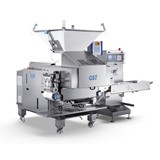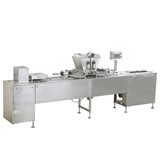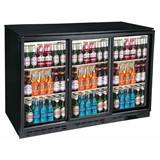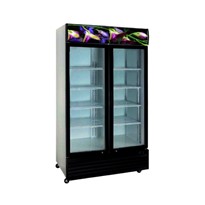What factor, in the view of postharvest experts, is the most important in keeping cut flowers fresh? You guessed it: the chill factor.
The importance of preserving the "cold chain" as a flower travels from the producer to the flower store has been convincingly shown through research. The cold chain, however, does not end there.
The most crucial tool you have for increasing the life of your cut flowers is your flower fridge. Investing time and money to keep it clean and in good functioning order is well worth it.
It's not just about the cool…
Temperature impacts every aspect of a flower's lifespan, including water loss, flower opening, stem bending, petal wilting, flower fall, the risk of botrytis infection, and more, as well as how cut flowers and plants react to ethylene. Of course, as a report on the Chain of Life website (www.chainoflife.org) points out, the temperature at which cut flowers are stored has an impact on consumer buying decisions—and retail florist earnings.
When it comes to purchasing and maintaining a flower fridge, temperature control isn't the only concern. What distinguishes a floral refrigerator from the rest? Humidity and airflow are two factors to consider. Unscrupulous suppliers marketing drink fridges as floral fridges are all too common when shopping on the Internet. If you're a beverage shop, you don't want all those cardboard boxes and carrying cases to get soggy and fall apart, therefore a beverage fridge is meant to keep things dry.
“What distinguishes a flower refrigerator from other types of fridges? Airflow and humidity.”
Everything in a well-designed floral fridge, on the other hand, has been developed for temperature and humidity balance. The capacity of the evaporation system in the fridge is adjusted with the power of the condensing unit (which controls the temperature) to keep humidity high even as the temperature drops.
Flowers require a high level of humidity. They also require gentle ventilation (even in the winter, a strong breeze might dry them up).
An ethylene gas filter and a temperature and humidity monitor are the final elements that could distinguish a top-notch floral refrigerator. Filters for ethylene can be purchased separately, however, they are occasionally included with the fridge. For around $200, you can get a temperature and humidity monitor that will log both measurements every 15 minutes and report them to a database that you can access from your home computer—just in case there are power outages or other issues that keep you awake at night thinking about that case of wedding flowers you just processed for the weekend.
Purchases that are worthwhile
When buying a flower fridge, make sure the compressor has a five-year warranty and that the work is covered. The installation of your floral fridge is also vital for its long life and proper operation. Foreign material can enter the system if proper piping practices are not followed, especially in the case of a larger fridge. It is possible for liquid to return to the compressor.
Take care
Regular preventive maintenance not only saves money on repairs and prevents catastrophic failures, but it also ensures that even the best-designed and installed flower fridge is resistant to temperature fluctuations and other irregular performance. Whether you prefer to do it yourself (which is quite doable) or hire a professional, you need to follow these steps:
- Clean the condensing unit once a month. The heart of your walk-in fridge is the condensing unit. The compressor, condensing coil, and condensing fan motor are all found here. It could be on top of the fridge, at a distant area, or even underneath it. It should just take around 15 minutes to clean. First, turn off the electricity to the unit. Then, using a powerful vacuum, blast away the dust and debris that has accumulated. To produce a blowing action, reverse the airflow (or use compressed air), which is more forceful and effective than vacuuming alone.
- Clean and sterilize the evaporator fan assembly once a year. Inside the walk-in fridge, you'll find this assembly. It moves the air around and removes the heat. It also collects water before draining it. Always remember to turn off the power first. Also, removing the drain pan will make it easier to reach the assembly's components.
- Clean and inspect the seals on the fridge doors at least once a year. (You might wish to clean the evaporator fan assembly at the same time.) The seals should be flexible and form a secure seal against the cabinet. You should replace them if they are torn or fragile.
- Clean all surfaces at least once a week: walls, floors, and shelves. Depending on how busy your fridge is, you may need to do this more frequently. Cleaning the outdoor surfaces is also a good idea. Many florists use a mild bleach solution, but a quaternary ammonium-based professional floral cleaning is considerably more effective.
How cold is cold?
Cut flowers and potted plants (excluding tropical species) should be quickly cooled to proper temperatures after harvesting and kept at the right temperatures along the cold chain. Recommended temperatures for postharvest care are +5°C to +14°C. When it comes to flower longevity, the lower the temperature, the better.
Flower fridges come with humidity settings that range between 80% and 95%, depending upon the types of plants you are housing within the fridge (arid plants require less humidity).
The cost of operating a floral fridge is heavily influenced by the doors in a display fridge, which may open and close repeatedly throughout the day. A larger fridge, of course, necessitates more power. Maintaining a separate fridge for long-term storage vs flowers ready for immediate sale, if you have the possibility, may be beneficial in keeping flowers fresh while keeping expenses down.
The bottom line, however, is based on the reality that flower longevity is what consumers care about the most, and they're prepared to spend for it, according to market research. Aren't you supposed to be?



-160x160-state_article-rel-cat.png)
-160x160-state_article-rel-cat.png)


























